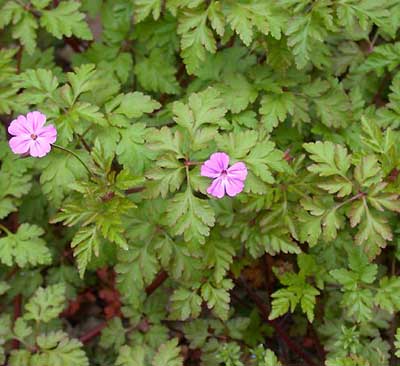Contents:
Common Names | Parts Usually Used | Plant(s) & Culture | Where Found | Medicinal Properties
Legends, Myths and Stories | Uses | Formulas or Dosages | Bibliography
Scientific Names

- Geranium robertianum L.
- Geranium family
Common Names
- Dragon’s blood
- Storkbill
- Wild crane’s-bill
Parts Usually Used
The entire plant
Back to Top
Description of Plant(s) and Culture
Herb Robert is a disagreeable-smelling annual or perennial plant, 6-18 inches high; the reddish stem is glandular-hairy, thick, juicy, and forked. The opposite, palmate, 3-5 toothed segment, leaves with pinnate or pinnatifid leaflets are deep green, often tinged with red. The purplish-red or rose colored flowers grow in pairs from May to October. The 5 petals are not notched but have long claws which suggest the long bill of a stork or crane.
Back to Top
Where Found
Found in rocky woods, roadsides, ditches, waste places from Nova Scotia south to Pennsylvania and west to Manitoba and Missouri; also common in Europe, Asia, and North Africa.
Back to Top
Medicinal Properties
Astringent, styptic
Back to Top
Legends, Myths and Stories
Some say, as does the Webster’s Dictionary, that this plant was named after Robert, Duke of Normandy or possibly after St. Robert, founder of the Carthusians.
Farmers for centuries have used Herb Robert for treating cattle.
Back to Top
Uses
Internal use is recommended for diarrhea, gastritis, enteritis, gout, and external hemorrhage. A hot poultice of boiled leaves is said to be good for bladder pains, fistulas, bruises, erysipelas, malaria, tuberculosis, stomach ailments, intestinal ailments, jaundice, gargle for sore throat, kidney infections, tumors, ulcers, and persistent skin problems. The green, crushed leaves are applied to relieve pain and inflammation. Use the tea also as a rinse for inflammations of the mouth, and the dilute tea as an eyewash. Externally, wash or poultice used to relieve swollen breasts, wounds, and is a folk remedy for cancer.
Back to Top
Formulas or Dosages
Remove any developing fruit before using.
Infusion: steep 1 level tbsp. dried herb in 1 cup water for a short time. Take 1 cup per day.
Cold extract: use 2 tsp. dried herb with 1 cup cold water. Let stand for 8-10 hours in a covered pot.
Back to Top
Bibliography
![]() The Complete Medicinal Herbal
The Complete Medicinal Herbal, by Penelope Ody, Dorling Kindersley, Inc, 232 Madison Avenue, New York, NY 10016, First American Edition, copyright 1993
![]() Culpeper’s Complete Herbal & English Physician: Updated With 117 Modern Herbs
Culpeper’s Complete Herbal & English Physician: Updated With 117 Modern Herbs, by Nicholas Culpeper, Meyerbooks, publisher, PO Box 427, Glenwood, Illinois 60425, 1990, (reprint of 1814)
![]() Eastern/Central Medicinal Plants
Eastern/Central Medicinal Plants, by Steven Foster and James A. Duke., Houghton Mifflin Company, 215 Park Avenue South, New York, NY 10000
![]() The Herb Book
The Herb Book, by John Lust, Bantam Books, 666 Fifth Avenue, New York, NY. copyright 1974.
![]() Planetary Herbology
Planetary Herbology, by Michael Tierra, C.A., N.D., O.M.D., Lotus Press, PO Box 325, Twin Lakes. WI 53181., Copyright 1988, published 1992
![]() Webster’s New World Dictionary
Webster’s New World Dictionary, Third College Edition, Victoria Neufeldt, Editor in Chief, New World Dictionaries: A Division of Simon & Schuster, Inc., 15 Columbus Circle, New York, NY 10023
